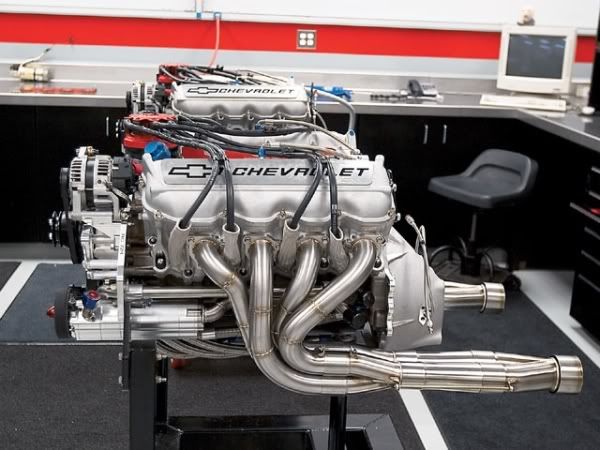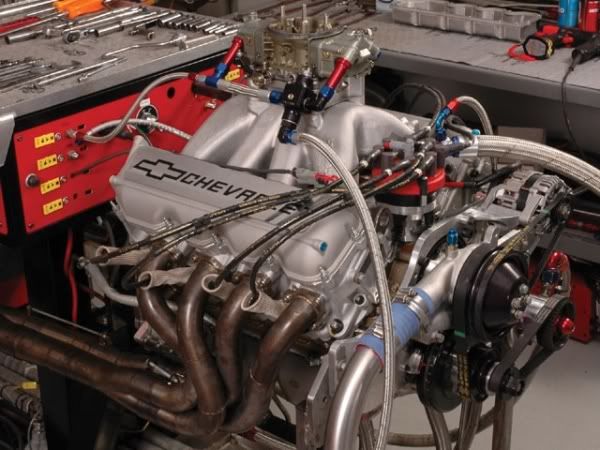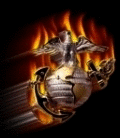Engine Porn
Just as the title suggests, this is Engine Porn, engines that are just plain sexy to look at. Those of you who are into engines will know what I am talking about; those who are not interested in racing or fast cars will probably just have to skip this. This is for the guys and gals who are gear heads (or petrol heads as they are known down-under). I have selected a few legendary powerplants that have made their mark in auto racing over the last 50 years as well as some newer engines on the cutting edge.
We'll begin with the small-block Chevy, the winningest motor in history when one takes into account every type of motorsport in which the engine has been used. From stock car, drags, road racing, boats, trucks - the small-block Chevy has been the staple powerplant due to availability (and hence, pricing) and interchangability (mix and match) of parts. Now there's a new small-blcok Chevy, the R07 NASCAR engine with modifications enabling reliable operation at engine speeds approaching 10,000 RPM and power levels well over 800 HP for extended periods required in NASCAR and other forms of long-distance racing.

This is the all new small-block Chevy R07 designed for NASCAR Nextel Cup racing. Aside from having a push-rod actuated, 2 valve per cylinder layout, it has nothing in common with the previous design except for being a V8.

A fully dressed R07.
I couldn't find a video showing the R07 on a dyno, but this will get your blood flowing just the same. It's a NASCAR Tour motor with a small (rules mandated) 390cfm carb, and it sounds awesome! In case you have problems with the video loading, here's the direct link.
We'll begin with the small-block Chevy, the winningest motor in history when one takes into account every type of motorsport in which the engine has been used. From stock car, drags, road racing, boats, trucks - the small-block Chevy has been the staple powerplant due to availability (and hence, pricing) and interchangability (mix and match) of parts. Now there's a new small-blcok Chevy, the R07 NASCAR engine with modifications enabling reliable operation at engine speeds approaching 10,000 RPM and power levels well over 800 HP for extended periods required in NASCAR and other forms of long-distance racing.

This is the all new small-block Chevy R07 designed for NASCAR Nextel Cup racing. Aside from having a push-rod actuated, 2 valve per cylinder layout, it has nothing in common with the previous design except for being a V8.
Per NASCAR specifications, the Chevrolet R07 displaces a maximum of 358 cubic inches with a maximum cylinder bore diameter of 4.185 inches. The block is a precision iron casting with integral oil and coolant passages that eliminate the need for most exterior lines. The distance between the Chevrolet R07's cylinder bores is 4.500-inch (vs. 4.400 inches in the SB2 small-block). This wider bore spacing improves coolant circulation around the cylinder barrels. In conjunction with a targeted cooling system, the R07 block design minimizes temperatures at critical locations.Read the rest of the informative "white paper."
The R07 block has a new six-bolt head bolt pattern instead of the small-block's traditional five-bolt design. The revised head bolt pattern improves head gasket sealing and reduces cylinder bore distortion.
The R07's camshaft is located higher in the block than the camshaft in the SB2. The raised cam operates pushrods that are correspondingly shorter and stiffer, thereby improving valvetrain dynamics at high rpm. The raised cam also provides clearance for inboard piston squirters that spray the underside of the pistons with oil for cooling. The camshaft tunnel is isolated from the crankcase to minimize windage losses caused by oil falling onto the rotating crankshaft assembly from the cam and to contain the valvetrain parts in the event of breakage.
In contrast to the SB2's "mirror port" cylinder heads, the Chevrolet R07's aluminum cylinder heads resemble production LS-series small-block cylinder heads with alternating intake and exhaust valves. The R07's shallow valve angle produces a compact, efficient combustion chamber design that produces the required compression ratio with a lightweight flat-top or slightly domed piston. GM Racing engineers optimized the R07's intake port layout for the single, centrally mounted four-barrel carburetor mandated by NASCAR.
The aluminum intake manifold has an extended plenum to equalize fuel distribution among the cylinders. The manifold is dry; a separate valley cover carries coolant from the cylinder heads. The R07's distributor is located at the front of the engine to facilitate adjustments in ignition timing.
The Chevrolet R07 rocker covers are rigid cast aluminum with O-ring seals. The covers incorporate integral valve spring oilers that are pressure fed from passages in the cylinder heads, eliminating the need for external oil lines. GM Racing also designed a high-efficiency water pump and a carbon fiber front cover that shields the aftermarket camshaft belt drives used by NASCAR teams.

A fully dressed R07.
I couldn't find a video showing the R07 on a dyno, but this will get your blood flowing just the same. It's a NASCAR Tour motor with a small (rules mandated) 390cfm carb, and it sounds awesome! In case you have problems with the video loading, here's the direct link.
Labels: Auto Erotica









1 Comments:
I am not only a computer dummy but an automotive dummy too!
I got thrown out of Auto Mechanics in high school.
All though (with my b-i-law on the phone)I did take out a radiator and reinstalled it!
Post a Comment
<< Home